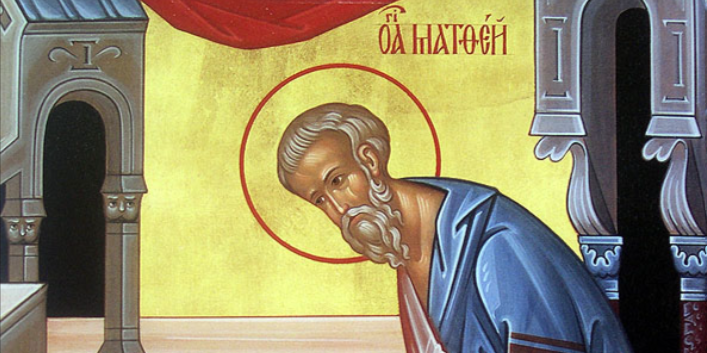Saint Matthew then stood up unharmed, and the people were amazed at this miracle. Seeing the power of God at work, many of them believed in Christ and were baptized. Fulvian, however, remained stubborn in his unbelief and ordered his soldiers to kill the Apostle Matthew. They struck him down with a sword, and thus the holy Apostle received the crown of martyrdom.
His holy relics were later taken to Salerno, Italy, where they are venerated to this day. Saint Matthew is remembered by the Church on November 16th, and his life and teachings continue to inspire Christians to follow Christ with faith and devotion.
The body of the holy apostle remained unharmed, and he departed to the Lord.
The ruler Fulvian deeply repented of his deed, but still he had doubts. By his command, they put the body of Saint Matthew into an iron coffin and threw it into the sea. In doing this Fulvian said that if the God of Matthew would preserve the body of the apostle in the water as He preserved him in the fire, then this would be proper reason to worship this One True God.
That night the Apostle Matthew appeared to Bishop Platon in a dream, and commanded him to go with clergy to the shore of the sea and to find his body there. The righteous Fulvian and his retinue went with the bishop to the shore of the sea. The coffin carried by the waves was taken to the church built by the apostle. Then Fulvian begged forgiveness of the holy Apostle Matthew, after which Bishop Platon baptized him, giving him the name Matthew in obedience to a command of God.
Soon Saint Fulvian-Matthew abdicated his rule and became a presbyter. Upon the death of Bishop Platon, the Apostle Matthew appeared to him and exhorted him to head the Ethiopian Church. Having become a bishop, Saint Fulvian-Matthew toiled at preaching the Word of God, continuing the work of his heavenly patron.
This Apostle, who was also called Levi, was the son of Alphaeus and had Galilee as his homeland. A publican before being called by Christ, he became one of the Twelve Apostles, and an Evangelist. While still in Palestine, he wrote his Gospel first in Hebrew, being also the first of all to write the Gospel. When he is depicted in icons, there is portrayed next to him the likeness of a man, one of the symbolic living creatures mentioned by Ezekiel (1.10), which, as Saint Irenaeus writes, is a symbol of our Saviour’s Incarnation.
Matthew, son of Alphaeus, was a tax collector when the Lord saw him in Capernaum and said: Follow Me. And he arose, and followed Him (Matthew 9:9). After that, Matthew prepared a reception for the Lord in his home and thus provided the occasion for the Lord to express several great truths about His coming to earth. After receiving the Holy Spirit, Matthew preached the Gospel to the Parthians, Medes and Ethiopians.
In Ethiopia he appointed his follower Plato as bishop, and withdrew to prayerful solitude on a mountain, where the Lord appeared to him. Matthew baptized the wife and the son of the prince of Ethiopia, at which the prince became greatly enraged and dispatched a guard to bring Matthew to him for trial. The soldiers returned to the prince saying that they had heard Matthew’s voice, but could not see him with their eyes.
The prince then sent a second guard. When this guard approached the apostle, he shone with a heavenly light so powerful that the soldiers could not look at him; filled with fear, they threw down their weapons and returned. The prince then went himself. Matthew radiated such light that the prince was instantly blinded. However, the holy apostle had a compassionate heart; he prayed to God, and the prince was given back his sight. Unfortunately, he saw only with physical eyes and not spiritual eyes.
He arrested Matthew and subjected him to cruel tortures. Twice, a large fire was lighted on his chest, but the power of God preserved him alive and unharmed.
Then the apostle prayed to God and gave up his spirit. The prince commanded that the martyr’s body be placed in a lead coffin and thrown into the sea. The saint appeared to Bishop Plato and told him where the coffin bearing his body could be found. The bishop retrieved the coffin with Matthew’s body from the sea.
Witnessing this new miracle, the prince was baptized and received the name Matthew. After that, the prince left all the vanity of the world and became a presbyter and served the Church in a God-pleasing way.
When Plato died, the Apostle Matthew appeared to the presbyter Matthew and counseled him to accept the episcopacy. He accepted the bishopric and, for many years, was a good shepherd until the Lord called him to His Immortal Kingdom.
St. Matthew the Apostle wrote his Gospel in the Aramaic language. It was soon after translated into Greek and the Greek text has come down to us, while the Aramaic text has been lost. It is said of this evangelist that he never ate meat, but only vegetables and fruit.

